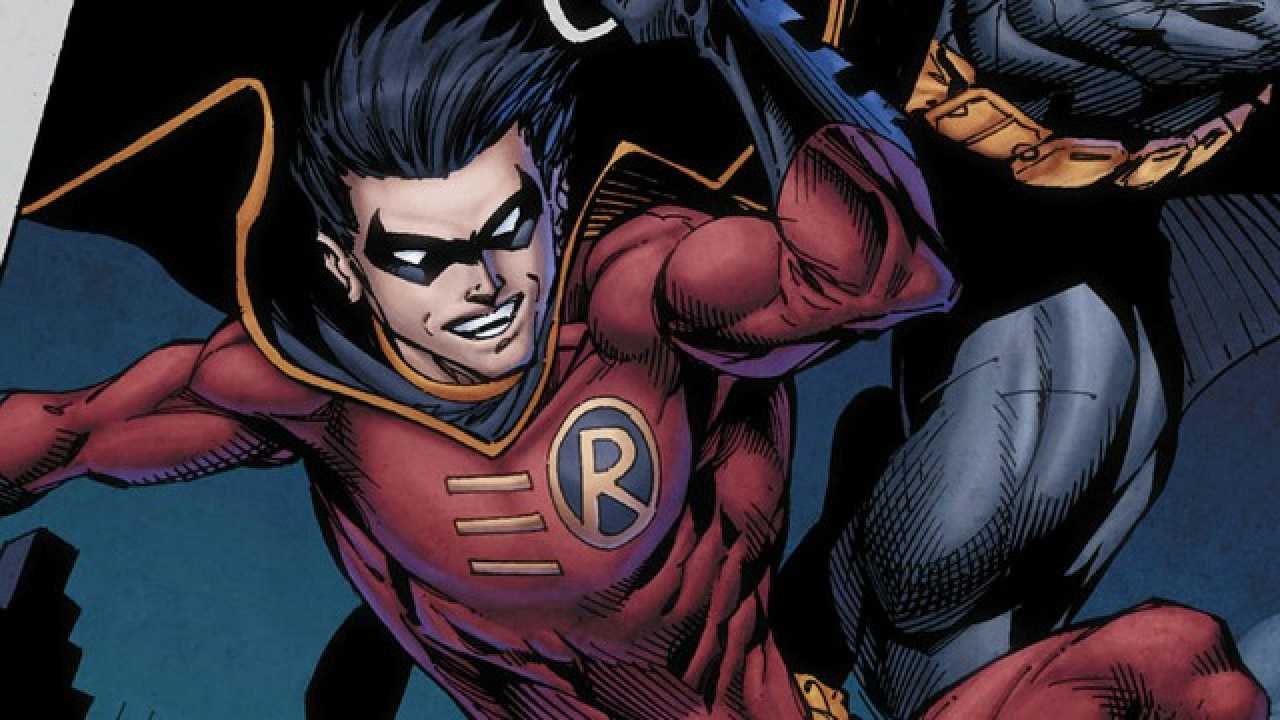
With the impending return of Tim Drake in the pages of Detective Comics, it’s as good a time as any to look back on the character’s near thirty-year history and recall what makes him so popular in the Batman mythos. But why do people love him? Declarations such as “Tim is the best Robin” often mean “He’s my favorite”, and that usually comes with “He’s the one I grew up with/am the most familiar with.” Despite Dick Grayson’s more global popularity and forty-year stint in the role, modern fans prefer his adventures as Nightwing, whether in the pages of the Titans comics or his own solo series. Jason Todd was too controversial and inconsistently written of a character for many to say he was their favorite during his tenure. Additionally, there have been several Robins to come after Tim Drake, and he wasn’t even the immediate third, lest we forget Carrie Kelley. Of course, there are other reasons people say they like Tim the best, but when examining Dick Grayson’s long history, the two share similarities. Tim’s detective skills, for instance, are often hailed as a unique trait unto himself, but Dick Grayson was a detective for his entire career as well. Tim was the first Robin to have an ongoing solo series, but Dick had solo features in continuous back-ups such as Batman Family and Detective Comics on as well.
The more tangible reasons for naming Tim as the best Robin character doesn’t need to be point-scoring against the others. Right away, Tim is the Robin with the most trackable character development, from his introductions in Batman Year III and A Lonely Place of Dying, through his solo series and team-up books, to his continued adventures as Red Robin. Since 1989, the character has arguably had more progression and growth than any Robin or even Batman in the span of twenty-eight years. What we’ll be doing is going through his history and note key moments that stood out during his character’s evolution.
PROLOGUE: PRE-TIM DRAKE

In 1983, Dick Grayson retired the mantle of Robin the (then) Teen Wonder, emerging as a new hero called Nightwing. His development hit a milestone, but by that point Dick had been operating on his own independent of Batman for years. Although he was known the world over as Robin the Boy Wonder on cartoons like the Superfriends and the 1970s Batman cartoon, Dick had, in fact, moved out of Wayne Manor and attended college since 1969. He had partnered with Batman on and off over the following decade, but in 1980 he led the soon-to-be extremely successful DC series The New Teen Titans, a series that saw him and his super-powered teammates save the world on several occasions. Firmly established as a strong character in his own right, Dick’s graduation into Nightwing would be a move that invariably kept him away from the Bat-Books for the next ten years.
Everyone knows what came next, but for the uninitiated, Jason Todd became Robin the same year Dick became Nightwing. Initially given an origin that shamelessly echoed Dick Grayson (he too was an orphaned acrobat from the Flying Todds in the Sloan Circus), his backstory was re-written in 1987 to that of a street orphan, fending for himself by stealing tires off cars. Batman finds him in Crime Alley after “boosting” the tires off the Batmobile, and after an adventure in which Jason helps him take down a criminal orphanage, he makes him the new Robin.
Here’s the thing about Jason Todd. Popular online journalism and commentators talk about how he went from a Dick Grayson knock-off to an ugly, ill-behaved kid who people voted to destroy. The fact is, from 1983 to 1988, the character went through many different portrayals. While his initial origin was insultingly similar to Dick Grayson’s, there was an ongoing story line about his transition to Robin that developed in the issues of Batman written by Gerry Conway, his creator. After the second origin, writer Max Allen Collins gave Jason a chip on his shoulder due his upbringing and learning that Two-Face murdered his father. When that story ended, two versions of Jason existed in the two Bat-Books. In Detective Comics by Mike W. Barr and Alan Davis, Jason was written very much like his initial version: a good kid who was new at crime fighting and would blunder into trouble (Barr’s Jason even invoked the infamous “Holy–!” euphemisms made famous by Burt Ward).

Simultaneously in the pages of Batman, Jason was written by Jim Starlin. This is the version of Jason Todd that people are most familiar with. While he was still an ambitious crime fighter, Starlin’s Jason took on the more violent aspects of his personality that famously characterized him in later stories like Under the Hood.

While I’ve no sales figures to work with in determining which title readers read more, history dictates that enough people were not happy with Starlin’s Jason Todd, or Jason Todd period.
Long story short, he blew up.
It’s important to know these factors that went into creating Tim Drake. Denny O’Neil, Editor of the Batman Books in the 80s and 90s, has spoken numerous times about the backlash from readers concerning Jason’s character. The solution was clear: bring back the classic Batman and Robin team. But would Dick Grayson return to the mantle at age 20?
Let’s take note of the original third Robin, Carrie Kelley. Appearing in the miniseries Batman: The Dark Knight (The Dark Knight Returns), that timeline saw a 55-year old Batman who presumably retired after Robin (Jason Todd) had died. When returning to the mantle after ten years, Batman meets Carrie who’s inspired to become Robin after he saved her from the Mutant gang. When questioned by Alfred as to why he’d endanger another young person after what happened to Jason, Batman responded that “The war goes on.”

This story was in 1986, two years before Jason’s canonical demise in A Death in the Family. While it eerily presaged his fate, would Batman take to a third partner in the same way?
PRE-ROBIN

Tim Drake technically first appeared in flashback sequence in Batman #436 during Batman Year 3, and was hinted at in Batman #440, but it wasn’t until The New Titans #60 where the character made his first full-on appearance. A Lonely Place of Dying begins when mysterious stranger is shown to have stalked Batman for some time before moving on to find Dick Grayson. After striking out in New York with the Titans, he finds Grayson with his old family circus and after watching him solve a mystery he frantically informs Dick that Batman’s in danger and needs his help as Robin. Dick takes the young stranger, a thirteen-year old Tim Drake, to Wayne Manor where he meets Alfred and tells them his story. On the night Dick’s parents were killed, a very young Tim was in the audience with his family. Before the Graysons died, they took a photo with the Drakes, and after that night Tim had nightmares of seeing the Graysons fall and Batman (at the time of this origin, Batman was on the scene when the Flying Graysons died to comfort Dick). Years later, he watched TV footage of Batman and Robin fighting the Penguin when he witnessed Robin perform a quadruple flip, the same one only the Flying Graysons were famous for performing. From then on, he surmised the identities of Batman, both Robins and Nightwing. After Jason died, Batman grew more violent and reckless and Tim, fearing for his hero’s well-being, tracked Dick down to convince him to become Robin again.
Dick decides to help Batman, but as Nightwing. The two fall into a trap by Two-Face and get caught in an explosion. Fearing the worst, Tim dons the Robin suit, battles Two-Face and rescues Batman and Nightwing. Back at Wayne Manor, Bruce is still against the idea of a Robin but agrees to slowly take Tim under his wing.

In the 1990 trade edition of A Lonely Place of Dying, Denny O’Neil talks about writing a new Robin while avoiding the pitfalls of Jason Todd, without turning Robin into a Dick Grayson clone. The idea was to have the original approve of the newcomer; make Dick give his successor his blessing. More than that, fans needed to accept Tim Drake. So, did the writers go about creating a character that the fans would root for?
Their solution: to write them into the comic as the new Robin.
Let’s go back to the beginning. When we first properly meet Tim Drake (re)meeting Dick at Haly’s Circus, he’s trying to solve the mystery of the circus accidents on his own. Though he’s there to find Dick, he takes it upon himself to get the investigation going and solve the crime if no one else would. When Dick first sees him, Tim instantly alerts him to the idea of a crime and that he must solve it and get back to Batman.

Once at Wayne Manor, Tim says to Alfred “I know you’re Batman’s confidant, and I’ve dreamed about the stories you could tell.” before continuing on how much of everyone’s personal history he’s familiarized himself with.
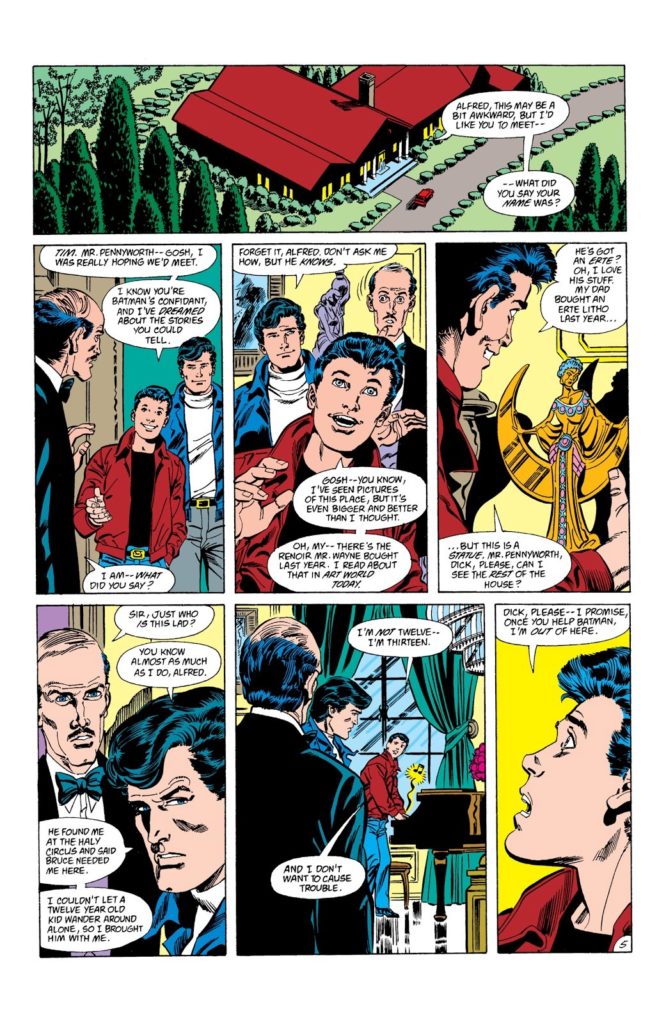
He insists that he knows what’s best for Batman and Robin because he’s followed them half his life, learned everything about them and has striven to be like them. He keeps his grades up, exercises and practices Karate. When Dick rejects becoming Robin again, Tim is in tears.

Tim Drake is a fanboy. He’s a metatextual comment on the fans’ concerns of the Batman franchise and their love of the classic era with the Dynamic Duo. In his introduction for the A Lonely Place of Dying collection, O’Neil talked about how Batman had been around for then-fifty years, and was more real than the writers had kept in mind. The blow back he got after Jason died surprised him into realizing how deeply readers care about these fictional characters.
In writing Tim so sympathetically, DC at the time were more merciful than they could’ve been. Tim promises to leave once Batman and Robin are back together (although had things gone the way he wanted, who knows what new demands he might have come up with). Unlike the zero issue in the New 52, he never wanted to become Robin himself. He was more concerned with the well-being of the heroes he loved. He was smart, resourceful, inexperienced but not aggressively so. It was a meta-narrative so slickly written by Marv Wolfman that many fans never picked up on it.
Tim also spoke about the nature of Robin, and how the existence of a young partner helps keep Batman’s psyche in check. I’m unsure to what extent this take had been openly discussed in the comics before 1989, but it couldn’t have been expressed any more explicitly. Before, Dick Grayson stayed being Robin for adventure and to honor his parents. In both of Jason’s origins it went no further than simply filling the role.


Tim existed not just to have Robin exist, but to keep the love of the fans alive on the page. His argument to Batman is perfectly in line with what any thirteen-year old Batman fan would say to their hero. He avoids from becoming a Mary Sue thanks to his initial interactions with Dick, Alfred and Batman, none of which are copacetic. No one in the book is jumping up and down for Tim to hop into the green shorts, and he fights to earn everyone’s trust. But it’s a great start for the next Robin to ingratiate the characters of the comic and the readers at large.

At this point, Bruce begins ingratiating Tim into his world. This is a lengthy process, taking a solid year of issues between the Decembers of 1989 and 1990. It’s a period not often discussed or widely realized, but while Tim proved he had the smarts and skills to take to the training, in Bruce’s words the making of a good partner isn’t the same as being one.
Most of Tim’s development continued with his creator, Marv Wolfman, in the pages of Batman. While his parents were always away on business trips, Tim would go between boarding school and the Batcave, slowly observing Batman and honing his detective skills. Deducing Batman’s identity is one thing (and, if we’re being honest, not terribly hard). It’s another thing to absorb the skills needed to aid the world’s greatest detective. It’s also an element of Tim’s character that’s been taken for granted in recent years. While modern stories drone on about him being a “genius” and one of the smartest people in the world, Tim started out as a well-meaning, intelligent, but altogether normal kid. He was not a master detective from the get-go. His first unofficial case at Haly’s Circus he got entirely wrong, and in the months that followed we saw Tim improve his skills through trial and error.
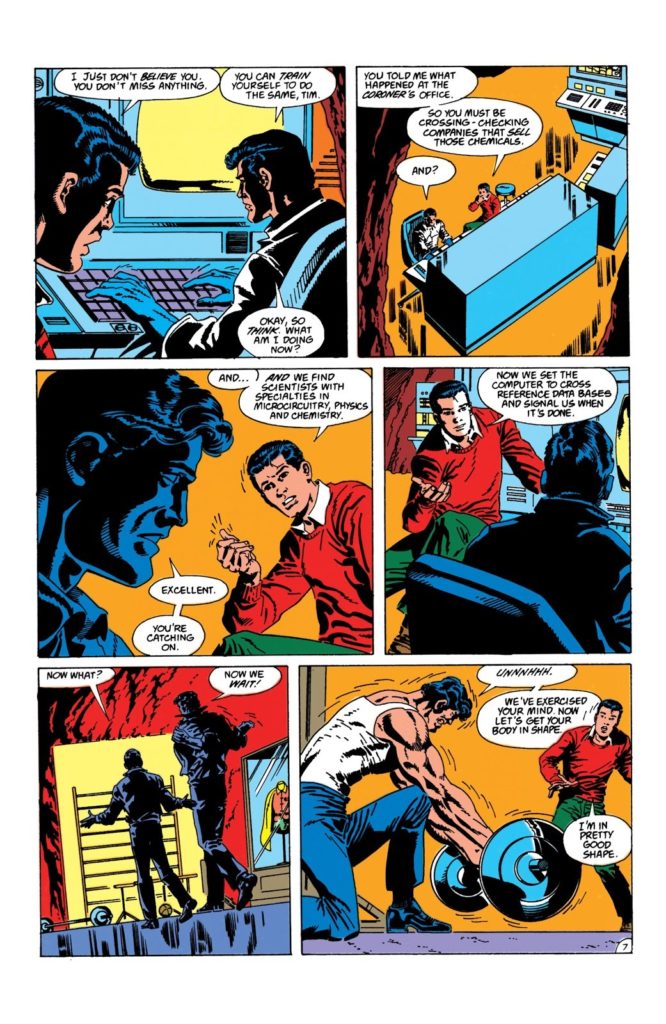
Consider also Bruce’s state of mind. It didn’t matter what Tim or the fans desired, he did not want another partner. He would never truly get over Jason’s death, especially given the reasons why he adopted Jason in the first place. Batman #416 established that Bruce missed the friendship he had with Dick, and Jason becoming Robin was, in a way, a chance to recreate that. Jason’s death had him realize that the life of a crime fighter was too dangerous for an ill-prepared teenager. So in the year that sees Tim study and learn to become Robin, there were no scenes of him at the firing range or base jumping like there usually were with Dick and Jason. For the whole of 1990, Tim is an understudy, a novice. He’s not suiting up and punching bad guys, he’s an assistant in the Batcave who’s there to take notes and never put himself in danger.


There are two important instances of development in Tim’s year of training. The first occurs not in the pages of Batman or Detective Comics, but in The New Titans. New Titans #65 has Tim visit Dick Grayson to learn how to be a better partner from Batman. And what better way to get instruction than from the first person who had the job?
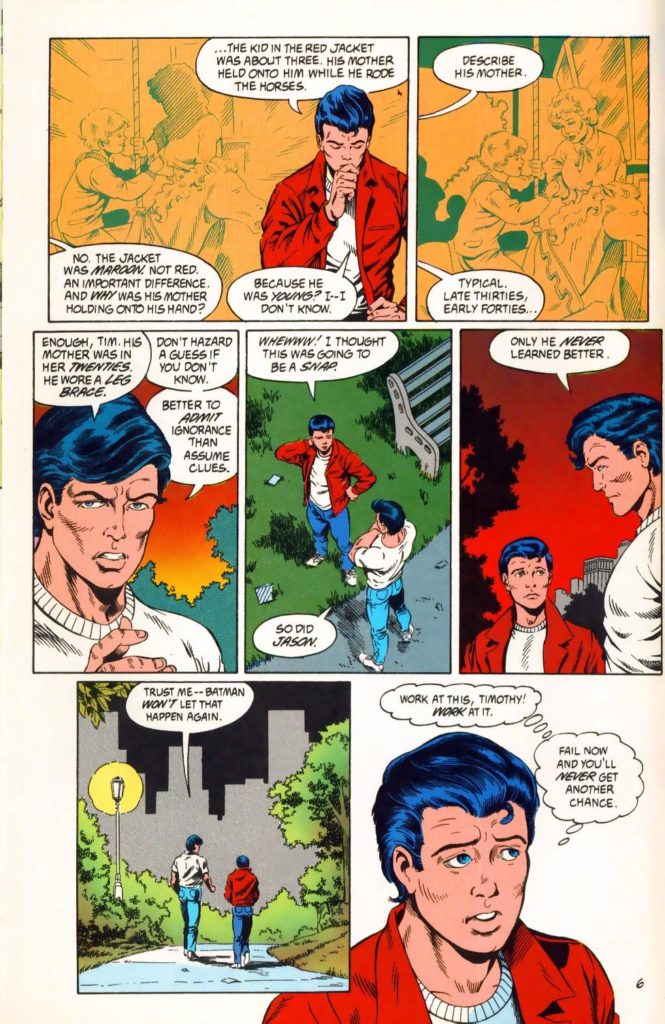
This is a very interesting issue because Dick takes to Tim in a brusque manner that is unlike any of their later interactions. These days, it’s well known that Dick and Tim provide the big brother-little brother dynamic in the Bat-Family. That developed over the course of the storylines Knightfall, Prodigal, and in the pages of Nightwing’s solo series later in the decade. In New Titans #65, Dick is a strict taskmaster who has no time for any of Tim’s novice approach. He takes him to a park and has him sit for seven hours without saying a word. While Tim presumed they were meant to meditate, Dick wanted him to describe everything in the park in order to hone his observation skills. It’s a student/teacher relationship more than a senpai/kouhai one. It tracks well with Dick’s characterization during his stint as the Titans’ leader. He was much more stern and serious, going through many shake-ups, both dramatic and personal. There’s also the subtext of Dick feeling responsible for Jason’s death. Dick and Jason rarely interacted aside from occasional scenes here or there. Jason wore his costume, so Dick felt guilty when his successor died wearing his colors. While it’s never explicitly stated what’s going through Dick’s head, the context (found especially in New Titans #55) informs his state of mind pretty easily.

The second occurs in Detective Comics #616 and continues in Batman #450. Upon realizing that the Joker is still alive after their last encounter at the end of A Death in the Family, Batman immediately put Tim on a plane and flew him out of Gotham. Batman #450 and #451 are both interesting issues in how it depicts not just Batman, but Commissioner Gordon’s anxiety in facing the Joker again after what he did to Barbara Gordon and Robin, unsure if they’ll try to kill him to avenge their loved ones. Joker is even hesitant to reappear after getting shot in the chest at the end of Death in the Family. While Tim himself doesn’t appear after leaving town, it’s an important story in seeing how the events of Death in the Family and The Killing Joke continued to have impact everyone in the Bat-Books for the next two decades.
TRAGEDY AND TRIUMPH
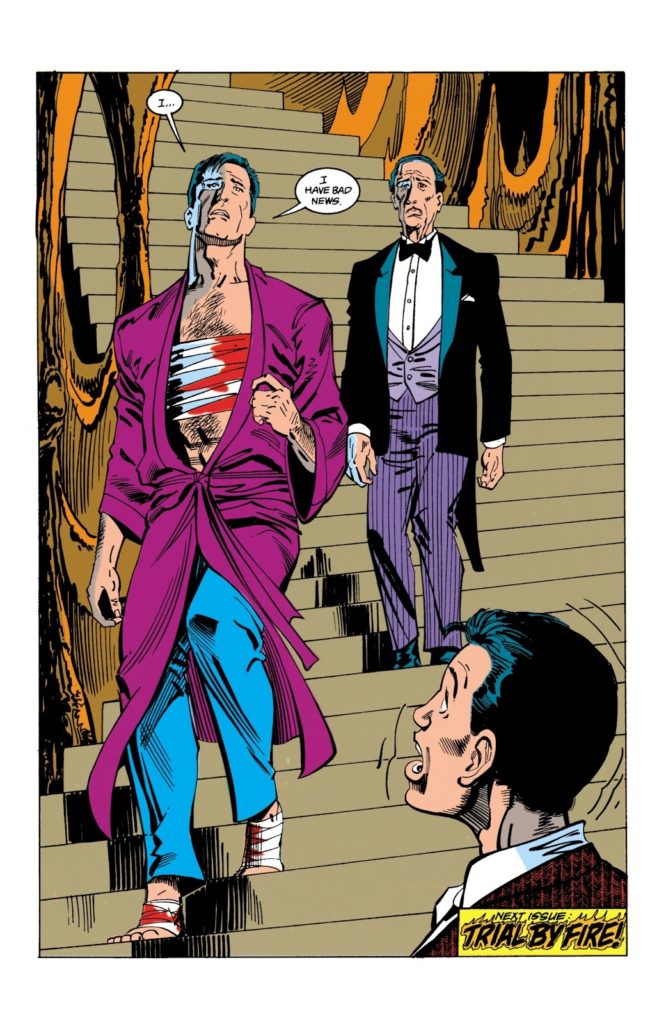
“Strange…Dick Grayson’s parents died…and gave the world Robin. And poor Jason…his parent, too. Maybe…maybe it’s something we all have to go through before…before we put on the suit.”
“Heaven forbid, sir! Don’t ever think like that! Not ever!”-Tim Drake and Alfred, Detective Comics #619.
What separates Tim Drake most from his predecessors is that he wasn’t orphaned by the murder of his parents? He wasn’t the live-in ward of Bruce Wayne due to a childhood trauma, as most of his eventual solo series showed him living at home with his parents. But it’s important to understand that he wasn’t without his own personal tragedy. While his father, Jack Drake, would regularly appear in Tim’s supporting cast, once upon a time Tim did have a mother.
Jack Drake was an industrialist who often traveled around the world with his wife, Janet. Leaving Tim at boarding school, the two were always away on business which accounted for how Tim could train with Batman as often as he did. When flying over the Caribbean in Detective Comics #618, their plane was brought down by The Obeah Man, the supposed leader of the Caribbean Economic Front. Taking the Drakes hostage, he sends Gotham a ransom tape which Batman uses to deduce their location. While Bruce leaves the country to rescue them, Tim stews in the Batcave trying not to worry and pours his energy into stop the cybercriminal known as Moneyspider.
This is an intense story, taking place between Detective Comics #618-#621. Up until now, Tim’s been a very patient, obedient student who always took Bruce at his word even if he disagreed. The obvious stress that comes with knowing your parents have been captured by a madman half the world away frays at Tim’s nerves, and he fights to keeps himself in check. The scene in ‘Tec #619, when Tim learns that his parents are still alive but are being held for ransom, is reminiscent to a scene in Batman #411, where a similarly green Jason Todd reacted badly to learning that his father was killed by Two-Face, and that Batman kept the information from him.
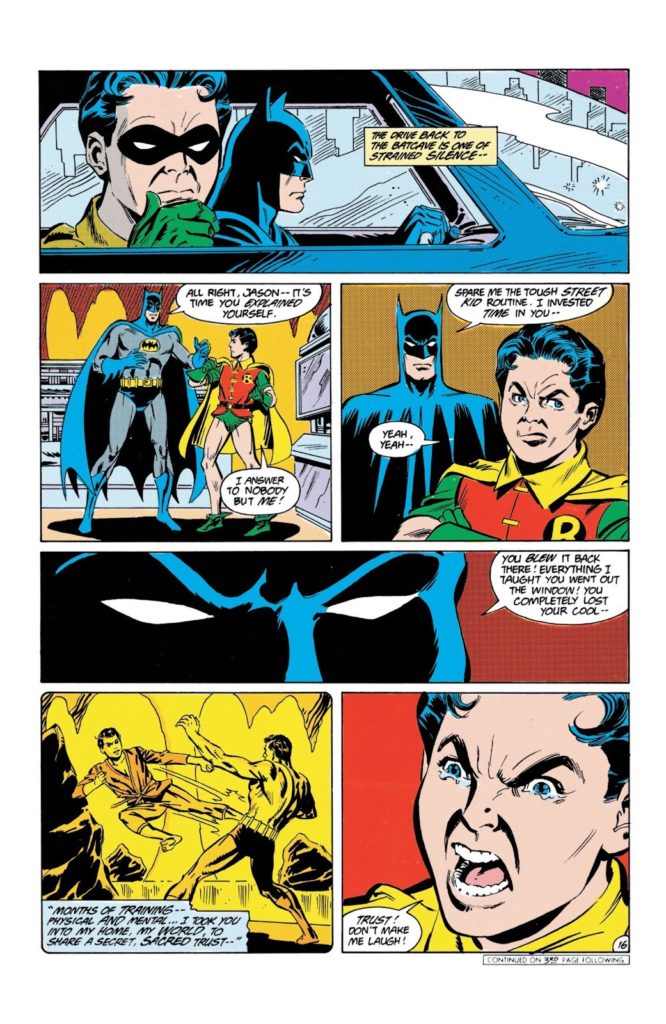

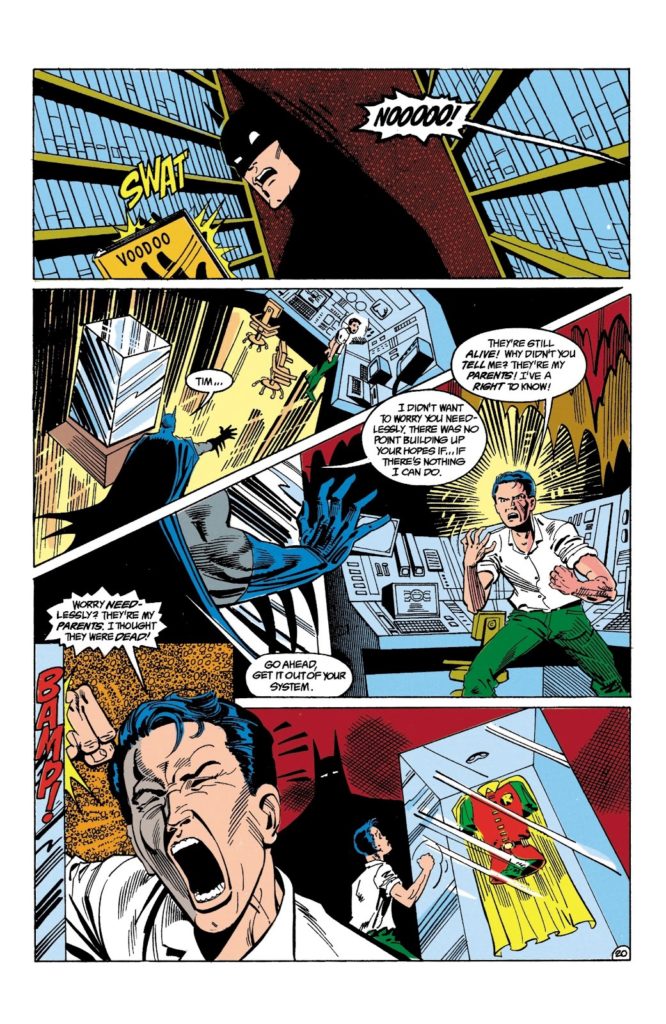
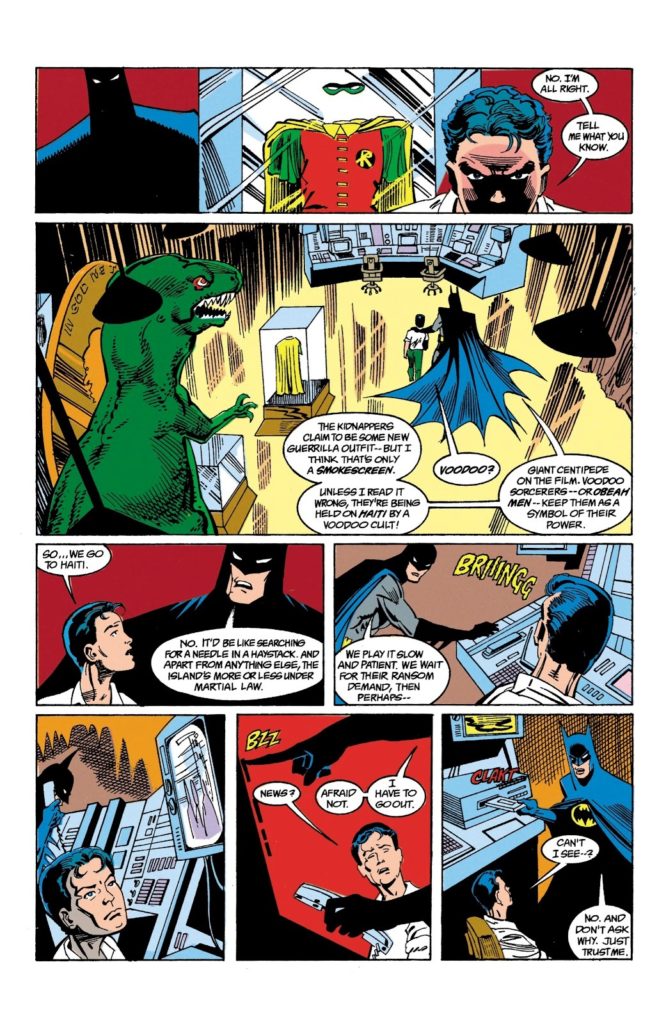
Whereas both young men react in anger, Tim has already been trained by this point to think things out logically, without emotion. Jason was famously put into the costume far too soon before he came to grips with the deaths of his parents. While Jason was Robin and Tim was not, comparing both young men’s emotional responses gives insight to how they took to the job of a crime-fighter differently, even with similar situations.

Tim puts everything he has into solving the Moneyspider crimes, deducing their point of origin and coming face to face with Lonnie Machin a.k.a Anarky. It’s the first case he solved entirely on his own, and he feels pretty good about it.

Unfortunately at that moment, Bruce comes down the stairs of the Batcave with a massive cut across his chest saying he has bad news.
We learn in Detective Comics #621 that Bruce tailed the pickup man for the Drakes ransom money back to The Obeah Man. The Obeah Man, an insane cultist with designs to make human sacrifices in the name of Baron Samedi, never had any intention of leaving the Drake alive and tied them to a stake to burn before their sacrifice.
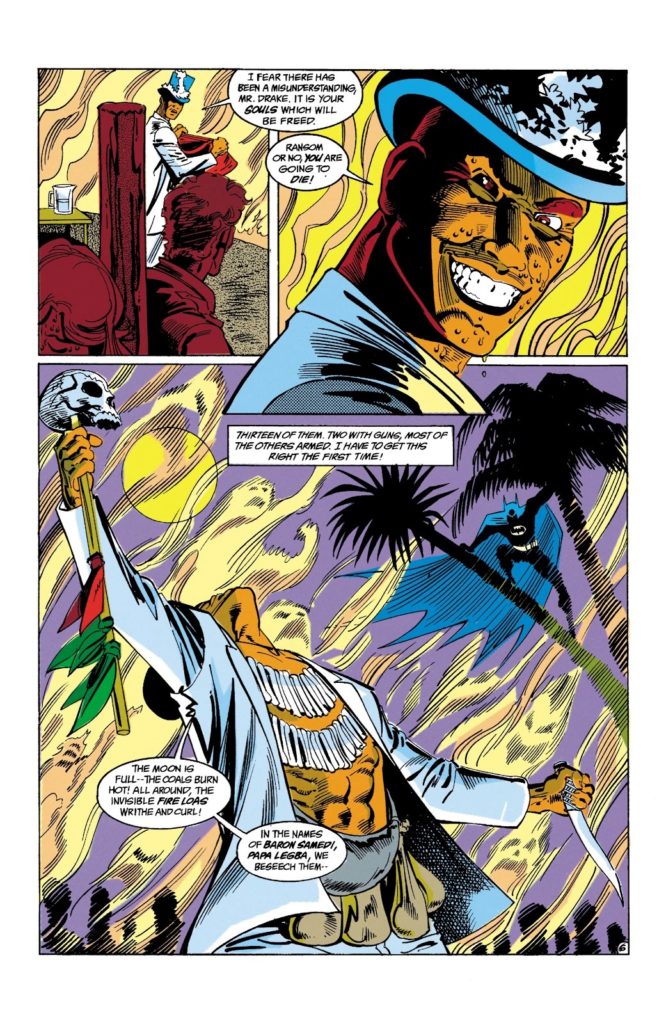
Bruce arrived in the nick of time, defeated The Obeah Man and freed Tim’s parents from their bonds. However, the surrounding heat parched the Drakes to the point of desperate thirst, so they went for the nearest pitcher of water they could see. To Batman’s horror, the water was, in fact, poison. He knocks it from Jack’s hand mid-gulp, but the damage has been done. Janet dies and Jack is a paraplegic from his ingesting the tainted water.
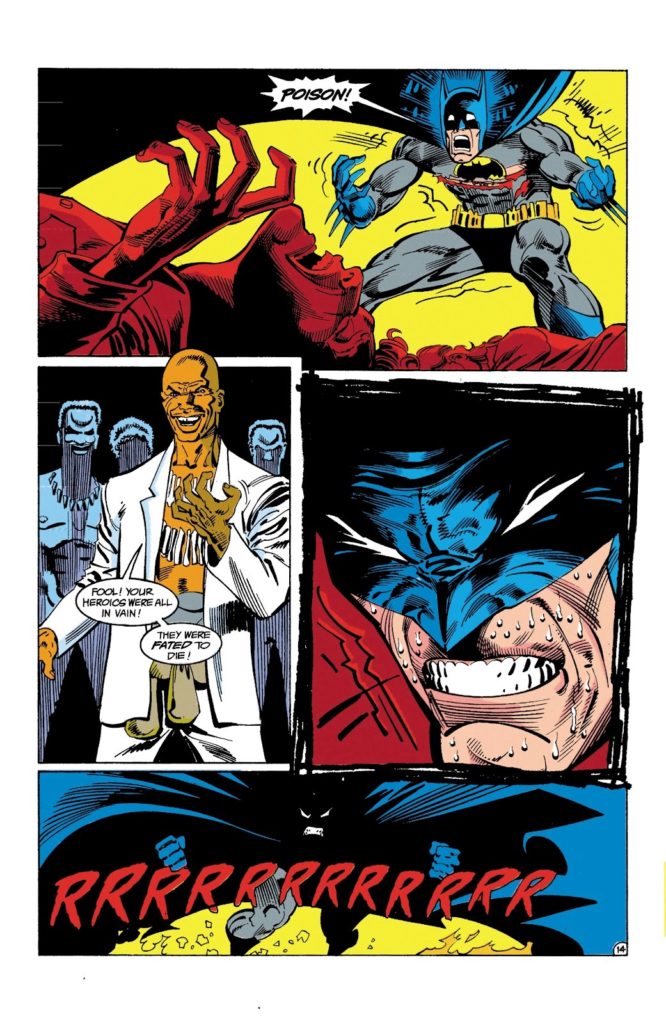

Tim is at an impasse. Was it fate that brought his parents to their demise? Was Tim always meant to go down this road for wanting to help Batman? Was it destiny, since he’d retroactively been a part of the Batman story since the death of the Flying Graysons? Was it Bruce’s fault somehow? Infecting everyone close to him with death?
These are questions that Bruce and Tim ask themselves in the closing pages of ‘Tec #621. It seemed like a cruel requirement that his parents couldn’t be around for him to be Robin, and yet, that’s how they got out of his way to finish his training. Looking back, it wasn’t 100% necessary for his mother to die and his father to be maimed. The New 52 just had his parents move away from Gotham City. Carrie Kelley’s parents were still alive when she became Robin, as were, later, Stephanie Brown’s. Of course, every character had extenuating circumstances and while the story in ‘Tec #618-621 might feel tacked on in Tim’s parents just HAVING to had something awful happen to them, it nonetheless added depth to his already weighty character. Tim was aiming to become Robin already. The issue of his parents before The Obeah Man wasn’t properly dealt with, Bruce never talked with Alfred about training a kid who was perfectly fine with his own family. Had the Obeah Man never happened, it would’ve been tough for Tim to hide his costumed life from Jack and Janet.
Then again, Jack would recover and re-marry and it was tough all the same, thus making Bruce’s training of Tim still relatively morally dubious. In any case, Tim now had the pain of loss to channel into crime fighting energy. So, would he be Robin yet?

Batman #455-457 is the final story in Tim’s pre-Robin training. While he buries his mother, mysterious slayings have been occurring in Gotham by people who have no memory of the acts and have no criminal record. When going out to investigate, Tim passionately tells Bruce that he’s ready to put on the Robin costume. Bruce maintains that he’s still not up to it, stating that if Tim ever disobeys him he will never become Robin.

Tim resolves to figure out who’s behind the murders in the Batcave, but comes up with nothing. There’s no link between each of the killers, and nothing thus far matches any of the usual rogues gallery’s M.O. as he passes out on the floor of the Batcave, he’s set upon by visions of the Dick Grayson Robin and the G-G-Ghost of Jason Todd.
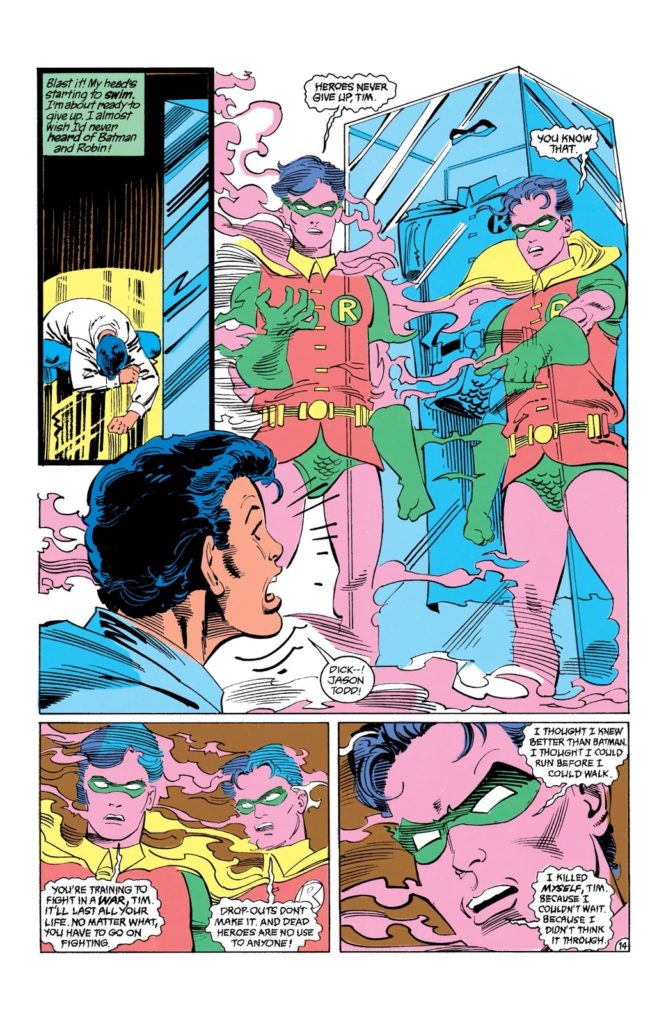
Tim awakes from his fever dream and deduces correctly that the mastermind behind the slayings is the Scarecrow. He tries phoning the police, but Commissioner Gordon refuses to send his men out on a hunch. Tim hesitates, vacillating between helping Batman and staying in the Batcave. If he’s wrong and fails, he’ll never be Robin. If he’s right and does nothing, Batman could die.

By this point Batman’s gotten himself captured (naturally), along with infrequently-appearing love interest Vicki Vale. Tim dons a ski-mask and brings his now-famous bo-staff, and jumps the Scarecrow. Despite getting doused with Fear Toxin, Tim manages to beat the Scarecrow by knocking him into vats of his own fear chemicals. After the police arrive, Batman tells Tim that while he disobeyed him, heroes get to break the rules on the justification that gut instincts can save lives, which in this instance, Tim’s did.

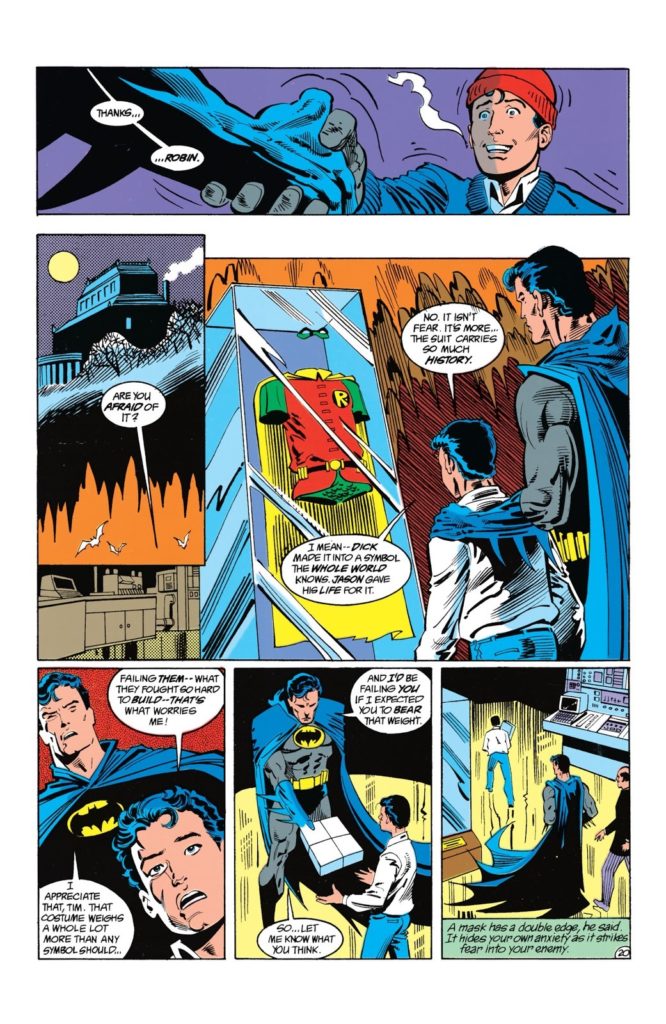
So, FINALLY, Tim becomes Robin!
While there were of course several stories that came after in the pages of Tim’s miniseries, solo series and adventures with Batman and other DC heroes that continued the maturation of his character, the year of his pre-costumed development is one that’s truly foundational in how slowly and carefully he was lead into the cape. We see Tim anxious, scared and aggressively ambitious, like all the Robins were at times. But he was also continuously anchored by a sense of doing the right thing because he believed in Batman. He hardly went against his orders and used his brain as his primary arsenal. It was never easy, and Tim had to hone his instincts in order to earn the role, but earn it he did, and Batman had at last his third partner.
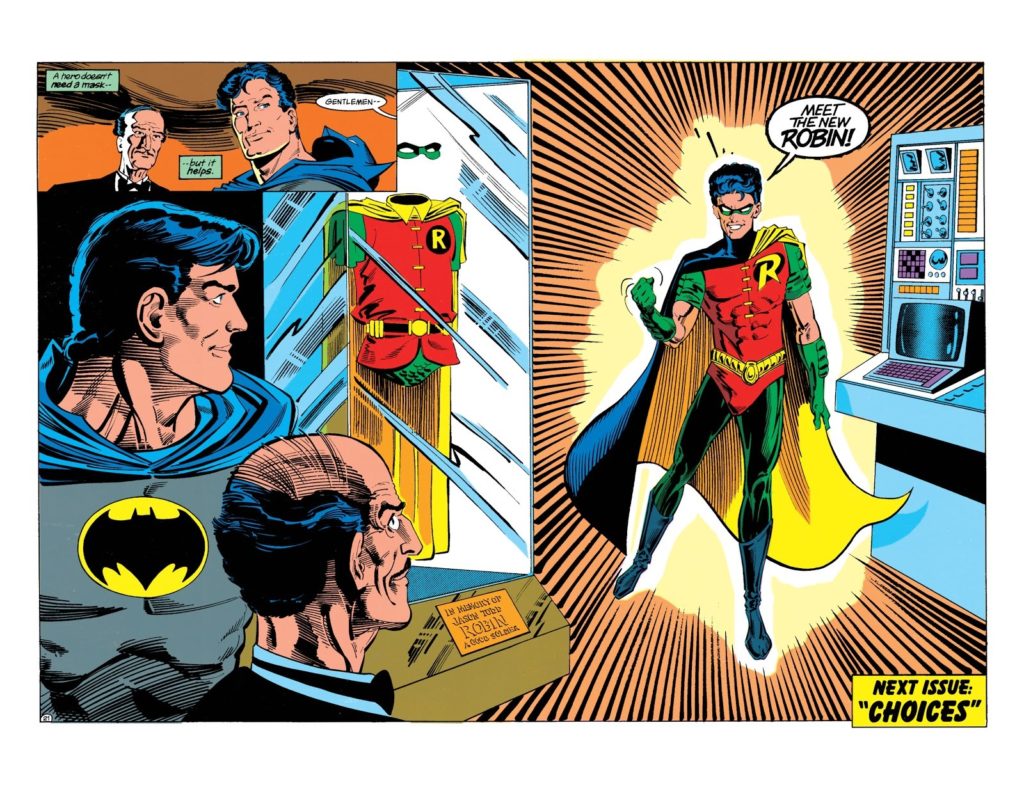
NEXT: Is this truly the end of Tim’s training? What adventures would take him across the world? And is love in the air for the Boy Detective? We’ll go over all that and more next time!
